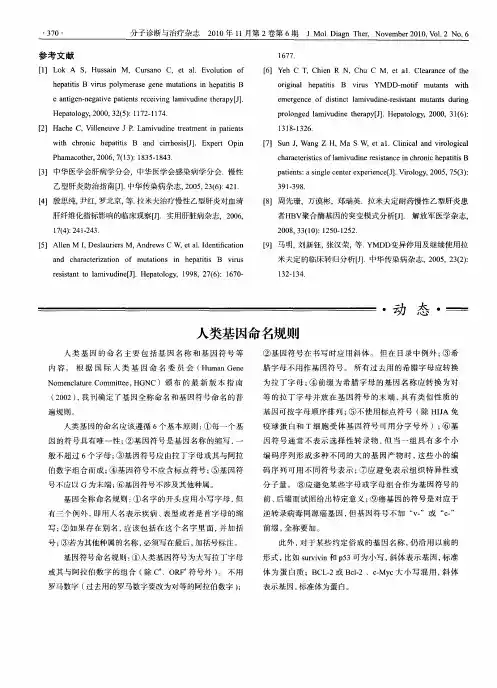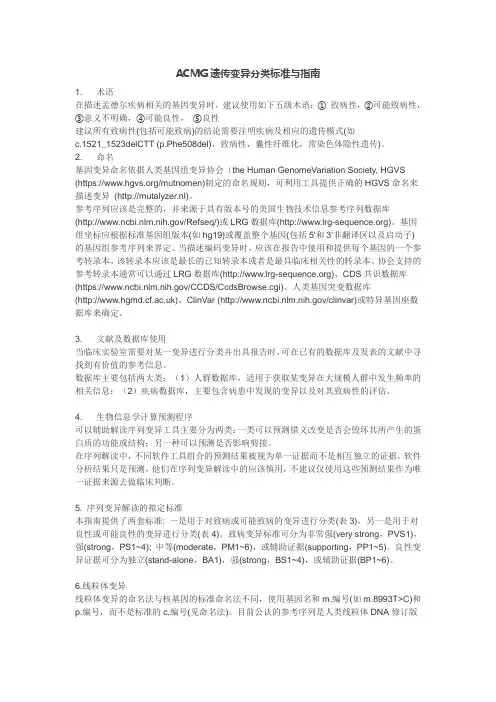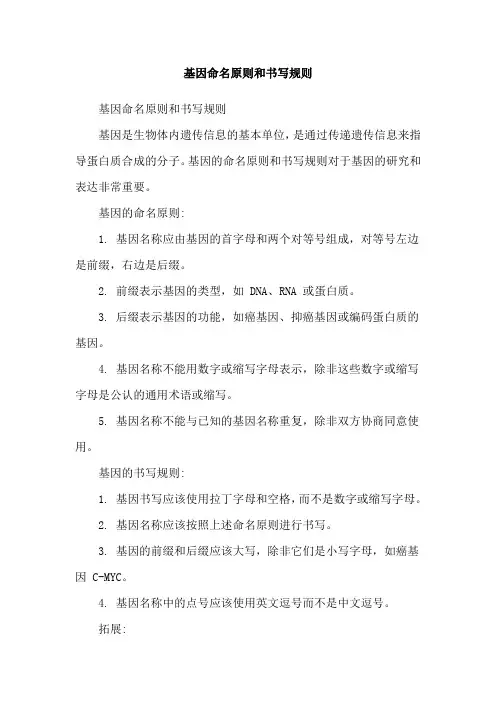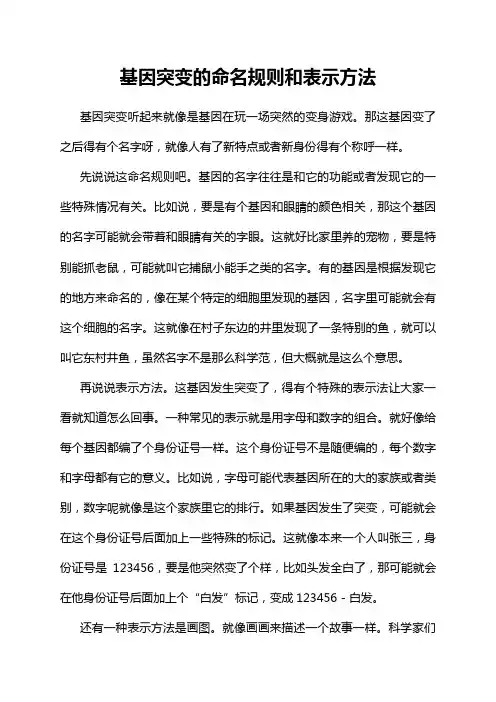最新HGVS基因突变命名规则速览
人类基因命名规则

基 因全 称命名规 则 : 名字 的开头应用 小写字母 , ① 但 有 三个 例外 , 即用人 名表示疾病 、 型或者是 首字母 的缩 表
逆转 录病毒 同源癌 基因 , 但基 因符号不 加 “ . v”或 “一 e” 前缀 , 全称要 加。
a c a a trz to o m u ai n i he tts B v r s nd h r c e iai n f tto s n paii i u
马 明 , 新 钰 , 汉 荣 , . MD 刘 张 等 Y D变 异 停 用 及继 续 使 用 拉
米夫定 的临床转归分析 [ _中华传染病杂志, 0 5 2 () J J 2 0 , 32:
3 — 98. 91 3
乙型肝炎防治指南[ . J 中华传染病杂志,0 5 2 ()4 1 ] 2 0 , 36:2 .
【】殷思纯, 4 尹红, 罗北京, 拉米夫治疗慢性乙型肝炎对血清 等.
周先 珊,万谟 彬,郑瑞英.拉米夫定耐药慢性 乙型肝炎患
肝纤维化指标影响的临床观察[ .实用肝脏病杂志,2 0, J ] 06
o gn l h p t i B v r s YM DD— t mua t wi i r i a e ai s i t u mo i f tn s t h e r e c f d si c a v dn —e it n t n s d r g meg n e o it t lmi u i e r ssa t mu a t u i n n
eat e—e av a et rciiglm v dn eayJ. ni nng t ept ns ee n iu i t rp [ g i i v a eh ]
HGVS基因变异命名规则

第26位的Trp变为终止密码
同义(=)
p.Cys123=
基因突变之后,氨基酸没有发生改变
缺失
del
p.Ala3_Ser5del
表示多肽序列中从第3位的Ala到第5位的Ser发生 了缺失
插入
ins
缺失插入 重复
delins
p.Lys2_Gly3insGlnSerLys
在第2位的Lys和第3位的Gly之间插入了 GlnSerLys
缺失插入
指与参考序列相比,一个或多个碱基 被其他碱基所取代的现象,并且这种 变异不包括替换突变、倒置以及转换 突变
重复
指与参考序列相比,包含一个或多个 碱基的拷贝以插入的形式直接掺入序 列中的现象
>
c.123A>T,表示与参考序列相比,第123位的A 被T所取代
del
c.2052delA,表示与参考序列相比,第2052位发 生A的缺失
4代表变异类型为移码变异主要是针对蛋白水平而言如parg456glyfster17或parg456glyfs17ext代表变异类型为延长主要是针对起始密码子和终止密码子变异导致的蛋白水平的改变如pmet1ext5gom表示获得甲基化如g1234567812345901gomlom表示去甲基化如g1234567812345901lommet表示甲基化如g1234567812345901met缩写字符的含义基因结构编码区cds
AGC变成CGC, AGG或AGA • “/”:表示嵌合体(mosaic),如NM_004006.1:c.145=/C>T • “//”:表示异源嵌合体(chimeric),如NM_004006.1:c.85=//T>C • “|”:代表不是序列的直接改变,而是一种修饰或一种状态的改变,如甲基化。 • “::”:用于描述RNA融合转录本和断点连接形成的环状染色体
ACMG遗传变异分类标准与指南

ACMG遗传变异分类标准与指南1. 术语在描述孟德尔疾病相关的基因变异时,建议使用如下五级术语:①致病性,②可能致病性,③意义不明确,④可能良性,⑤良性建议所有致病性(包括可能致病)的结论需要注明疾病及相应的遗传模式(如c.1521_1523delCTT (p.Phe508del),致病性,囊性纤维化,常染色体隐性遗传)。
2. 命名基因变异命名依据人类基因组变异协会(the Human GenomeVariation Society, HGVS (https:///mutnomen)制定的命名规则,可利用工具提供正确的HGVS命名来描述变异(http://mutalyzer.nl)。
参考序列应该是完整的,并来源于具有版本号的美国生物技术信息参考序列数据库(/Refseq/)或LRG数据库()。
基因组坐标应根据标准基因组版本(如hg19)或覆盖整个基因(包括5'和3'非翻译区以及启动子)的基因组参考序列来界定。
当描述编码变异时,应该在报告中使用和提供每个基因的一个参考转录本。
该转录本应该是最长的已知转录本或者是最具临床相关性的转录本。
协会支持的参考转录本通常可以通过LRG数据库()、CDS共识数据库(https:///CCDS/CcdsBrowse.cgi)、人类基因突变数据库()、ClinVar (/clinvar)或特异基因座数据库来确定。
3. 文献及数据库使用当临床实验室需要对某一变异进行分类并出具报告时,可在已有的数据库及发表的文献中寻找到有价值的参考信息。
数据库主要包括两大类:(1)人群数据库,适用于获取某变异在大规模人群中发生频率的相关信息;(2)疾病数据库,主要包含病患中发现的变异以及对其致病性的评估。
4. 生物信息学计算预测程序可以辅助解读序列变异工具主要分为两类:一类可以预测错义改变是否会毁坏其所产生的蛋白质的功能或结构;另一种可以预测是否影响剪接。
在序列解读中,不同软件工具组合的预测结果被视为单一证据而不是相互独立的证据,软件分析结果只是预测,他们在序列变异解读中的应该慎用,不建议仅使用这些预测结果作为唯一证据来源去做临床判断。
基因命名原则和书写规则

基因命名原则和书写规则基因命名原则和书写规则基因是生物体内遗传信息的基本单位,是通过传递遗传信息来指导蛋白质合成的分子。
基因的命名原则和书写规则对于基因的研究和表达非常重要。
基因的命名原则:1. 基因名称应由基因的首字母和两个对等号组成,对等号左边是前缀,右边是后缀。
2. 前缀表示基因的类型,如 DNA、RNA 或蛋白质。
3. 后缀表示基因的功能,如癌基因、抑癌基因或编码蛋白质的基因。
4. 基因名称不能用数字或缩写字母表示,除非这些数字或缩写字母是公认的通用术语或缩写。
5. 基因名称不能与已知的基因名称重复,除非双方协商同意使用。
基因的书写规则:1. 基因书写应该使用拉丁字母和空格,而不是数字或缩写字母。
2. 基因名称应该按照上述命名原则进行书写。
3. 基因的前缀和后缀应该大写,除非它们是小写字母,如癌基因 C-MYC。
4. 基因名称中的点号应该使用英文逗号而不是中文逗号。
拓展:1. 基因命名的历史:基因命名始于 20 世纪 60 年代,当时科学家们开始使用符号和缩写字母来表示基因。
随着时间的推移,这些符号和缩写字母逐渐演变成了现在的基因名称。
2. 基因的表达方式:基因的表达方式包括 RNA、蛋白质和 DNA 等形式。
RNA 和蛋白质形式的基因通常通过转录和翻译过程来产生。
DNA 形式的基因则是通过细胞分裂和有丝分裂等过程来复制和传递。
3. 基因的调控:基因的表达受到多种因素的影响,包括基因的激活、抑制和剪切等。
基因的调控还可以通过转录因子、酶和蛋白质等生物分子来实现。
基因命名原则和书写规则对于基因的研究和表达非常重要,有助于科学家们更好地理解基因的功能和调控机制。
基因突变命名规则

基因突变命名规则
基因突变命名规则一般遵循以下原则:
1.基因命名:采用大写字母表示基因名,如BRCA1。
2.突变类型:将突变类型作为前缀,如点突变用c.表示,缺失用del 表示,插入用ins表示等。
3.位置表示:位置表示采用cDNA序列为参照基准,如c.123C>T表示第123位碱基从C变为T。
4.突变描述:突变描述以“→”表示,如c.123C>T→p.Leu41Phe表示c.123C>T所引起的氨基酸突变为Leu41Phe。
5.多个突变:多个突变使用“,”分隔,如c.123C>T,c.456C>T表示两个点突变。
6.复杂突变:复杂突变可采用定量描写方法,如c.[123C>T;456A>G]表示两个点突变同时出现。
例如,对于BRCA1基因的突变c.68_69delAG,可以解释为:基因名称为BRCA1,突变类型为缺失(del),位置在cDNA序列的第68-69位上发生,缺失的碱基对为AG。
基因突变的命名规则和表示方法

基因突变的命名规则和表示方法基因突变听起来就像是基因在玩一场突然的变身游戏。
那这基因变了之后得有个名字呀,就像人有了新特点或者新身份得有个称呼一样。
先说说这命名规则吧。
基因的名字往往是和它的功能或者发现它的一些特殊情况有关。
比如说,要是有个基因和眼睛的颜色相关,那这个基因的名字可能就会带着和眼睛有关的字眼。
这就好比家里养的宠物,要是特别能抓老鼠,可能就叫它捕鼠小能手之类的名字。
有的基因是根据发现它的地方来命名的,像在某个特定的细胞里发现的基因,名字里可能就会有这个细胞的名字。
这就像在村子东边的井里发现了一条特别的鱼,就可以叫它东村井鱼,虽然名字不是那么科学范,但大概就是这么个意思。
再说说表示方法。
这基因发生突变了,得有个特殊的表示法让大家一看就知道怎么回事。
一种常见的表示就是用字母和数字的组合。
就好像给每个基因都编了个身份证号一样。
这个身份证号不是随便编的,每个数字和字母都有它的意义。
比如说,字母可能代表基因所在的大的家族或者类别,数字呢就像是这个家族里它的排行。
如果基因发生了突变,可能就会在这个身份证号后面加上一些特殊的标记。
这就像本来一个人叫张三,身份证号是123456,要是他突然变了个样,比如头发全白了,那可能就会在他身份证号后面加上个“白发”标记,变成123456 - 白发。
还有一种表示方法是画图。
就像画画来描述一个故事一样。
科学家们会画一个基因的结构,正常的基因结构画出来就像一个设计好的房子蓝图。
要是基因发生了突变,就在这个蓝图上把突变的地方标出来。
这就好比房子蓝图上,某个房间本来是卧室,现在因为基因突变变成了厨房,就在那个房间的位置画上厨房的标志。
这种画图的表示方法特别直观,就像看地图一样,一眼就能看出来基因哪里出了问题。
基因的命名规则和表示方法还有很多种,不同的领域可能会有不同的习惯。
这就像不同的地方有不同的方言,虽然有点不一样,但都是为了能把基因的突变这件事说清楚。
在我看来,基因突变的命名规则和表示方法虽然有点复杂,就像解开一团乱麻一样,但它非常重要。
突变命名规范
突变命名规范Nomenclature for the description of sequence variationsJ.T. den Dunnen, S.E. Antonarakis: Hum Genet 109(1): 121-124, 2001 Reproduced with kind permission from Prof. S. E. Antonarakis(last modified March 7, 2001)Questions and comments regarding nomenclature should be directed to Professor Stylianos Antonarakis( stylianos.antonarakis@medecine.unige.ch) or Dr. Johan T. den Dunnen ( ddunnen@lumc.nl). This page can also be found at the HGVSsite.ContentsIntroductionRecommendationsGeneralDNA-levelRNA-levelprotein-levelCodons and encoded amino acidsgenetic codeamino aciddescriptions (one / three letter code)IntroductionRecently, a nomenclature system has been suggested for the description of changes (mutations and polymorphisms) in DNA and protein sequences [Antonarakis,S.E. and the Nomenclature Working Group (1998) Recommendations foranomenclature system for human gene mutations. Hum.Mut. 11: 1-3]. These nomenclaturerecommendations have now been largely accepted and stimulated the uniform andunequivocal description of sequence changes. However, current rules do not yetcover all types of mutations, nor do they cover more complex mutations. Thisdocument lists the existing recommendations and summarizes suggestions for thedescription of additional, more complex changes, (shown in italics)based on a manuscript published in Human Mutation [den Dunnen, JT and Antonarakis,SE (2000). Mutation nomenclatureextensions and suggestions to describe complex mutations: a discussion. Hum.Mut. 15: 7-12] (copy in PDFformat).Discussions regarding the advantages and disadvantages of the suggestionsare necessary in order to continuously improve the designation of sequencechanges. The consensus of the discussions will be posted here and we inviteinvestigators to communicate with us regarding these suggestions. Furthermore,we invite investigators to send us complicated cases not covered yet, with asuggestion of how to describe these (mail to ddunnen@lumc.nl and Stylianos.Antonarakis@medecine.unige.ch).We hope these pages will be used as a guide to describe any sequence change,ultimately evolving into a uniformly accepted reference for mutationnomenclature description.General recommendations (suggestions extending the current recommendations are in italtics)The term "sequencevariation" is used to prevent confusion with the terms "mutation" and "polymorphism", mutation meaning "change" in some disciplines and "disease-causing change" in others and polymorphism meaning "nondisease-causing change" or "change found at a frequency of 1% orhigher in the population".The basic recommendation is to use systematic names to describe each sequence variation. For this, variations are described at themost basic level, i.e. the DNA level, using either a genomic or a cDNAreference sequence. A genomic reference sequence is preferred because itovercomes difficult cases, including multiple transcription initiation sites(promoters), alternative splicing, the use of different poly-Aadditionsignals, multiple translation initiation sites (ATG-codons) and the occurenceof length variations. When, like in most cases, the entire genomic sequence isnot known, a cDNA reference sequence should be used instead.sequencevariations are described in relation to a reference sequence for which theaccession number from a primary sequence database (Genbank, EMBL, DDJB,SWISS-PROT) should be mentioned in the publication/database submission(e.g. M18533)tabularlistings of the sequence variations described should contain columns forDNA, RNA and protein and clearly indicate whether the changes were experimentallydetermined or only theoretically deducedto avoidconfusion in the description of a sequence change, preceed the descriptionwith a letter indicating the type of reference sequence used;"g."for a genomic sequence (e.g. g.76A>T)"c."for a cDNA sequence (e.g. c.76A>T)"m."for a mitochondrial sequence (e.g. m.76A>T) (from David Fung, Camperdown, Australia)"r."for an RNA sequence (e.g. r.76a>u)"p."for a protein sequence (e.g. p.K76A)todiscrimintate between the different levels (DNA, RNA or protein),descriptions are unique;atDNA-level, in capitals, starting with a number refering to thefirstnucleotide affected (e.g. c.76A>T)atRNA-level, in lower-case, starting with a number refering to the firstnucleotide affected (e.g. r.76a>u)at proteinlevel, in capitals, starting with a letter referring to first the amino acid (one-letter code) affected (e.g. p.T26P)a range ofaffected residues is indicated by a "_"-character (underscore) separating the first and last residue affected (e.g. 76_78delACT)NOTE: current recommendations usethe "-"-character (i.e. 76-78delACT)fordeletions, duplications or insertions in short tandem repeats, the most 3'nucleotide is arbitrarily assigned as the nucleotide changedtwo sequence variations in one allele are listed between brackets, separatedby a "+"-character (e.g. [76A>C + 83G>C])NOTE: current recommendations use the ";"-character as a separator (i.e. [76A>C;83G>C])sequencechanges in different alleles (e.g. for recessive diseases) arelisted between brackets, separated by a "+"-character (e.g. [76A>C] + [87delG])NOTE: the current recommendation is [76A>C + 87delG]a uniqueidentifier should be assigned to each mutation. The unique OMIM-identifiercan be used, otherwise database curators should assign unique identifiersDNA levelnucleotides are designatedby the bases (in upper case); A (adenine), C (cytosine), G (guanine) and T(thymidine)nucleotide numbering;nucleotide +1 is the A ofthe ATG-translation initiation codon, the nucleotide 5' to +1 is numbered-1; there is no base 0non-coding regions;the nucleotide 5' of theATG-translation initiation codon is -1the nucleotide 3' ofthe translation termination codon is *1intronicnucleotides;beginning of theintron: the number of the lastnucleotide of the preceeding exon, a plus sign and the position in theintron, e.g. 77+1G,77+2T (when the exon number is known, the notation can alsobe describedas IVS1+1G,IVS1+2T)end of the intron: the number of the first nucleotide of the following exon, a minus sign and the position upstream in the intron,e.g. 78-2A,78-1G (when the exonnumber is known, the notation can also be described asIVS1-2A, IVS1-2G)for deletions, duplicationsor insertions in single nucleotide (or amino acid) stretches or tandemrepeats, the most 3' copy is arbitrarily assigned to have been changed(e.g. ACTTTGTGCC to ACTTTGCC is described as7_8delTG)Description of nucleotide changessubstitutions aredesignated by a “>”-character76A>C denotes that at nucleotide 76 a A is changed to a C 88+1G>T (alternatively IVS2+1G>T) denotes the G to T substitution at nucleotide +1of intron 2, relative to the cDNA positionedbetween nucleotides 88 and 8989-2A>C (alternativelyIVS2-2A>C) denotes the A to C substitution at nucleotide -2 of intron 2, relative to the cDNA positioned between nucleotides 88 and 89NOTE: polymorphicvariants are sometimes described as 76A/G, but this is not recommened !deletions are designated by "del"after the nucleotide(s) flanking the deletion site76_78del(alternatively 76_78delACT) denotes a ACT deletion from nucleotides 76 to7882_83del(alternatively 82_83delTG) denotes a TG deletion in the sequence ACTTTGTGCC(A is nucleotide 76) to ACTTTGCCIVS2_IVS5del(alternatives 88+?_923+? or EX3_5del) denotes an exonic deletion startingat an unknown position in intron 2 (after nucleotide 88) and ending at anunknown position in intron 5 (after nucleotide 923)insertions aredesignated by "ins" after thenucleotides flanking the insertion site, followed by the nucleotidesinsertedNOTE: as separator the "^"-character is sometimes used but this is not recommened (e.g. 83^84insTG)76_77insTdenotes that a T was inserted between nucleotides 76 and 7783_84insTGdenotes a TG insertion in the TG-tandem repeat sequence of ACTTTGTGCC (Ais nucleotide 76) to ACTTTGTGTGCC. Note that this sequencevariation (a duplicating insertion) can also be described as a duplication, i.e. 82_83dupTG (see "duplications")variabilityof short sequence repeats, e.g.in ACTGTGTGCC (A is nt 1991), are designated as1993(TG)3-6 withnucleotide 1993 containing the first TG-dinucleotide which is foundrepeated 3 to 6 times in the population.insertion/deletions(indels) are descibedas a deletion followed by an insertion after the nucleotidesafected112_117delinsTG(alternatively 112_117delAGGTCAinsTG or 112_117>TG) denotes thereplacement of nucleotides 112 to 117 (AGGTCA) by TGduplications are designated by "dup" after the nucleotides flanking theduplication site,77_79dupCTGdenotes that the nucleotides 77 to 79 were duplicated duplicatinginsertions in short tandem repeats (or single nucleotide stretches) canalso be described as a duplication, e.g. a TG insertion in theTG-tandemrepeat sequence of ACTTTGTGCC (A is nt 76) to ACTTTGTGTGCCcan be described as 82_83dupTG (now 83_84insTG)inversions are designated by "inv" after the nucleotides flanking theinversion site203_506inv(or 203_506inv304) denotes that the 304 nucleotides fromposition 203 to506 have been invertedtranslocations (no suggestions yet)changes indifferent alleles (e.g.in recessive diseases) are described as "[change allele 1] + [changeallele 2]"[76A>C] + [76A>C] denotes a homozygous A toC change at nucleotide 76[76A>C] + [?] denotes a A to Cchange at nucleotide 76in one allele and an unknown change in the other alleletwovariations in one allele are described as "[first change + second change]"[76A>C + 83G>C] denotes an A to C changeat nucleotide 76 and a G to C change at nucleotide 83 in thesame alleleNOTE: currentrecommendations use the ";"-character as a separator (i.e. [76A>C; 83G>C])RNA levelSequence changes at RNA level are basically described as those at the DNAlevel with the following modifications/additions;an “r.” isused to indicate that a change is described at RNA-level nucleotidesare designated by the bases (in lower case); a (adenine), c (cytosine), g(guanine) and u (uracil)78u>adenotes that at nucleotide 78a U is changed to an Awhen onechange affects RNA-processing, yielding two or moretranscripts, these aredescribed between square brackets, separated by a “;”-character[r.76a>c; r.76a>c +r.73_88del] denotes the nucleotide change c.76A>C causing the appearance oftwo RNA molecules, one carrying this variation only and one containing inaddition a deletion of nucleotides 73 to 88 (shift of the splice donorsite to within the exon)[r.=;r.88_89ins88+1_88+10 + r.88+2t>c] denotes the intronic mutationg.88+2T>C causing the appearance of two RNA molecules, one normal(r.=) and one containing an insertion of the intronic nucleotides 88+1 to88+10 with the nucleotide change 88+2t>c[r.88g>a +r.88_89ins88+1_88+10] denotes the nucleotide changec.88G>A causingan insertion of the intronic nucleotides 88+1 to 88+10 (shift of thesplice donor site to an intronic position)Protein levelSequence changes at protein level are basically described as those at the DNA level with the following modifications/additions;the one letter amino acid code is used, with "X" designating a translation termination codonAmino acidnumbering;thetranslation initiator Methionine is numbered as +1 Description of amino acid changessubstitutions;missensechangesW26C denotes thatamino acid 26 (Tryptophan, W) is changed to a Cysteine (C) nonsensechangesW26X denotes that aminoacid 26 (Tryptophan, W) is changed to a stop codon (X) initiatingmethionine (M1)Currently, mutations in the translation initiating Methionine (M1) aremostly described as a substitution, e.g. M1V. This is not correct. Eitherno protein is produced or the translation initiation site moves up- ordownstream. Unless experimental proof is available, it is probably bestto report the effect on protein level as “unknown”. When experimental data show that no protein is made, the description "p.0"might be most appropriateNOTE: polymorphicvariants are sometimes described as 36L/I, but this is not recommened !deletions are designated by "del" after the nucleotide(s) flanking the deletion siteK29del inthe sequence CKMGHQQQCC (C is amino acid 28) denotes a deletion of amino acid Lysine 29 (K) to CMGHQQQCCC28_M30deldenotes a deletion of three amino acids, from Cysteine 28 to Methionine30Q35del inthe sequence CKMGHQQQCC (C is amino acid 28) denotes a Glutamine 35 (Q) deletion to CKMGHQQCCif adeletion creates a new amino acid at the deletion junction the change isdescribed as an insertion/deletions, e.g. C28_M30delinsW (see below)insertions aredesignated by "ins" after the nucleotides flanking the insertion site, followed by the nucleotides insertedNOTE: as separator the "^"-character is sometimes usedbut this is not recommened (e.g. Q83^C84insQ)K29_M29insQSKdenotes that the sequence QSK was inserted between amino acidsLysine 29(K) and Methionine 30 (M), changing CKMGHQQQCC (C is amino acid 28)to CKQSKMGHQQQCCQ35_C36insQin the sequence CKMGHQQQCC (C is amino acid 28) denotes a Glutamine (Q)insertion to CKMGHQQQQCC. Note that this sequence variation(a duplicating insertion) can also be described as a duplication,i.e.Q35dup (see "duplications")if aninsertion creates a new amino acid at the insertion junction the changeis described as an insertion/deletions, e.g. C28delinsWV (see below)variabilityof short sequence repeats, e.g.in CKMGHQQQCC (C is amino acid 28), are designated as 33(Q)3-6 withamino acid Glutamine 33 (Q, the first repeated amino acid) found repeated3 to 6 times in the population.insertion/deletions(indels) aredescribed as a deletion followed by an insertion after the nucleotidesaffectedC28_K29delinsWdenotes a 3 bp deletion affecting the codons for Cysteine 28 and Lysine29, substituting them for a codon for TryptophanC28delinsWVdenotes a 3 bp insertion in the codon for Cysteine28, generating codonsfor Tryptophan (W) and Valine (V)duplications are designated by "dup" after the amino acids flanking theduplication siteG31_Q33dupin the sequence CKMGHQQQCC (C is amino acid 28) denotes a duplication ofamino acids Glycine 31 (G) to Glutamine 33 (Q) CKMGHQGHQQQCCduplicatinginsertions in short tandem repeats (or single amino acid stretches) canalso be described as a duplication, e.g. a HQ insertion in the HQ-tandemrepeat sequence of CKMGHQHQCC (C is amino acid 28) to CKMGHQHQHQCCcan be described as H34_Q35dup (now Q35_C36insHQ)frameshifting mutations; recommendations to describe these sequence changes have not yet beenmade. Although it is probably not useful to add much detail in thisdescription, it might be sensible, e.g. in the case of C-terminal mutations, to include the length of the new, shifted reading frame.R97fsX121(alternative R97fs) denotes a frame shifting change with Arginine97 asthe first affected amino acid and the new reading frame being open for 23amino acids。
基因的命名一般规则
基因的命名一般规则
好嘞,以下是为您生成的关于“基因的命名一般规则”的文章:
嗨,朋友们!今天咱们来聊聊基因命名那些事儿。
要说这基因的命名啊,那可是有不少讲究的。
首先呢,基因的名字
得简洁明了,可不能搞那些复杂得让人摸不着头脑的称呼。
比如说,
别弄一堆稀奇古怪的字母组合,让人看了就头疼。
基因名字要具有唯一性,不能跟其他已经存在的基因重名,要不然
科学家们在研究的时候准得乱套。
就像咱们每个人都有自己独一无二
的名字一样,基因也得有自己专属的“名号”。
还有哦,基因的命名得能反映出它的功能或者特点。
比如说,如果
一个基因跟眼睛的发育有关,那它的名字里最好能有点相关的提示,
这样大家一看名字就能大概知道这个基因是干啥的啦。
那啥样的名字不行呢?像那种特别随意、没有任何规律或者含义的
名字,那肯定是不行的。
还有那种特别冗长、复杂,读起来都拗口的
名字,也得被淘汰掉。
给大家举个例子哈,比如说有个基因叫“ABC123”,啥信息也没有,这就很不好。
但要是叫“眼睛发育相关基因X”,是不是一下子就清晰
多啦?
而且呀,基因命名还得遵循国际上的一些通用标准和规范。
这就好比全世界都在说同一种语言,交流起来才方便嘛。
要是每个地方都搞自己的一套,那科学研究还不乱成一锅粥啦。
总之呢,基因的命名可不是随便瞎搞的,得认真、严谨,还得清晰易懂。
这样大家在研究基因的时候,才能顺顺利利,不会被名字给搞晕喽。
好啦,希望我讲的这些能让您对基因的命名规则有个清楚的了解。
下次见咯!。
新冠变异毒株命名总结
新冠变异毒株命名总结随着新冠病毒在全球的持续传播,不同变异毒株的出现受到了广泛关注。
为了更好地描述这些变异毒株并方便相关研究和沟通,WHO和其他一些相关机构制定了一套变异毒株的命名规则。
本文将对这些规则进行总结和解析。
命名规则首先需要明确的是,新冠病毒变异毒株的命名不应该包含地理或人种等方面的信息,以避免种族歧视和恐慌情绪的产生。
因此,WHO制定了一个简单的字母和数字组合来表示每个毒株的特异性。
具体规则如下:1. 每个毒株都应该有一个独特的名称,名称中应包含一个(或多个)大写字母表示变异毒株的最显著特征、一个数字表示毒株的顺序、一个小写字母(可选)表示毒株的变异情况。
2. 大写字母可以从变异毒株的突变点、新功能、受影响的部位、变异后的蛋白质等方面来选择,但必须经过科学和医学共同的认可。
3. 每个新的变异毒株应该被尽可能快地提交到全球病毒数据库中,以便他人了解变异情况和及时掌握科学研究的进展。
4. 不允许使用名称中包含特定的国家或人种的词汇或符号,或给毒株命名时对任何地域或人群产生负面影响的符号或字母。
实践应用按照上述规则,已经有几个变异毒株被命名为Alpha、Beta、Gamma和Delta等名称。
比如,Alpha变异毒株是最早发现的变异毒株,它主要的突变位点是SARS-CoV-2的S蛋白上的501位置,因此被命名为B.1.1.7或Alpha。
同时,已经有一些新的变异毒株被发现,包括Epsilon、Zeta和Eta等等,它们都有着自己独特的变异情况。
这种命名规则的实践应用不仅可以避免对特定国家或民族的歧视,也更方便科学家和医生之间的沟通交流。
未来展望随着新冠病毒的全球传播,新的变异毒株的发现也将不断涌现。
因此,WHO的变异毒株命名规则将继续发挥它的作用,并在未来应用于更多的变异毒株中。
此外,命名规则的制定也将成为全球医学界和科学界的一个共识,有利于更好地沟通和交流研究成果,在全球范围内共同应对新冠病毒的挑战。
突变命名规范
突变命名规范Nomenclature for the description of sequence variationsJ.T. den Dunnen, S.E. Antonarakis: Hum Genet 109(1): 121-124, 2001Reproduced with kind permission from Prof. S. E. Antonarakis(last modified March 7, 2001)Questions and comments regarding nomenclature should be directed toProfessor Stylianos Antonarakis( stylianos.antonarakis@medecine.unige.ch) or Dr. Johan T. den Dunnen ( ddunnen@lumc.nl). This page can also be found at the HGVSsite.ContentsIntroductionRecommendationsGeneralDNA-levelRNA-levelprotein-levelCodons and encoded amino acidsgenetic codeamino aciddescriptions (one / three letter code)IntroductionRecently, a nomenclature system has been suggested for the description of changes (mutations and polymorphisms) in DNA and protein sequences [Antonarakis,S.E. and the Nomenclature Working Group (1998) Recommendations for anomenclature system for human gene mutations. Hum.Mut. 11: 1-3]. These nomenclaturerecommendations have now been largely accepted and stimulated the uniform andunequivocal description of sequence changes. However, current rules do not yetcover all types of mutations, nor do they cover more complex mutations. Thisdocument lists the existing recommendations and summarizes suggestions for thedescription of additional, more complex changes, (shown in italics)based on a manuscript published in Human Mutation [den Dunnen, JT and Antonarakis,SE (2000). Mutation nomenclatureextensions and suggestions to describe complex mutations: a discussion. Hum.Mut. 15: 7-12] (copy in PDFformat).Discussions regarding the advantages and disadvantages of the suggestionsare necessary in order to continuously improve the designation of sequencechanges. The consensus of the discussions will be posted here and we inviteinvestigators to communicate with us regarding these suggestions. Furthermore,we invite investigators to send us complicated cases not covered yet, with asuggestion of how to describe these (mail to ddunnen@lumc.nl and Stylianos.Antonarakis@medecine.unige.ch).We hope these pages will be used as a guide to describe any sequence change,ultimately evolving into a uniformly accepted reference for mutationnomenclature description.General recommendations (suggestions extending the current recommendations are in italtics)The term "sequence variation" is used to prevent confusion with the terms "mutation" and "polymorphism", mutation meaning "change" in some disciplines and "disease-causing change" in others and polymorphism meaning "nondisease-causing change" or "change found at a frequency of 1% orhigher in the population".The basic recommendation is to use systematic names to describe each sequence variation. For this, variations are described at themost basic level, i.e. the DNA level, using either a genomic or a cDNAreference sequence. A genomic reference sequence is preferred because itovercomes difficult cases, including multiple transcription initiation sites(promoters), alternative splicing, the use of different poly-Aadditionsignals, multiple translation initiation sites (ATG-codons) and the occurenceof length variations. When, like in most cases, the entire genomic sequence isnot known, a cDNA reference sequence should be used instead.sequencevariations are described in relation to a reference sequence for which theaccession number from a primary sequence database (Genbank, EMBL, DDJB,SWISS-PROT) should be mentioned in the publication/database submission(e.g. M18533)tabularlistings of the sequence variations described should contain columns forDNA, RNA and protein and clearly indicate whether the changes were experimentallydetermined or only theoretically deducedto avoidconfusion in the description of a sequence change, preceed the descriptionwith a letter indicating the type of reference sequence used;"g."for a genomic sequence (e.g. g.76A>T)"c."for a cDNA sequence (e.g. c.76A>T)"m."for a mitochondrial sequence (e.g. m.76A>T) (from David Fung, Camperdown, Australia)"r."for an RNA sequence (e.g. r.76a>u)"p."for a protein sequence (e.g. p.K76A)todiscrimintate between the different levels (DNA, RNA or protein),descriptions are unique;atDNA-level, in capitals, starting with a number refering to the firstnucleotide affected (e.g. c.76A>T)atRNA-level, in lower-case, starting with a number refering to the firstnucleotide affected (e.g. r.76a>u)at proteinlevel, in capitals, starting with a letter referring to first the amino acid (one-letter code) affected (e.g. p.T26P)a range ofaffected residues is indicated by a "_"-character (underscore) separating the first and last residue affected (e.g. 76_78delACT)NOTE: current recommendations usethe "-"-character (i.e. 76-78delACT)fordeletions, duplications or insertions in short tandem repeats, the most 3'nucleotide is arbitrarily assigned as the nucleotide changedtwo sequence variations in one allele are listed between brackets, separatedby a "+"-character (e.g. [76A>C + 83G>C])NOTE: current recommendations use the ";"-character as a separator (i.e. [76A>C;83G>C])sequencechanges in different alleles (e.g. for recessive diseases) are listed between brackets, separated by a "+"-character (e.g. [76A>C] + [87delG])NOTE: the current recommendation is [76A>C + 87delG]a uniqueidentifier should be assigned to each mutation. The unique OMIM-identifiercan be used, otherwise database curators should assign unique identifiersDNA levelnucleotides are designatedby the bases (in upper case); A (adenine), C (cytosine), G (guanine) and T(thymidine)nucleotide numbering;nucleotide +1 is the A ofthe ATG-translation initiation codon, the nucleotide 5' to +1 is numbered-1; there is no base 0non-coding regions;the nucleotide 5' of theATG-translation initiation codon is -1the nucleotide 3' ofthe translation termination codon is *1intronicnucleotides;beginning of theintron: the number of the lastnucleotide of the preceeding exon, a plus sign and the position in theintron, e.g. 77+1G,77+2T (when the exon number is known, the notation can alsobe describedas IVS1+1G,IVS1+2T)end of the intron: the number of the first nucleotide of the following exon, a minus sign and the position upstream in the intron,e.g. 78-2A,78-1G (when the exonnumber is known, the notation can also be described asIVS1-2A, IVS1-2G)for deletions, duplicationsor insertions in single nucleotide (or amino acid) stretches or tandemrepeats, the most 3' copy is arbitrarily assigned to have been changed(e.g. ACTTTGTGCC to ACTTTGCC is described as7_8delTG)Description of nucleotide changessubstitutions aredesignated by a “>”-character76A>C denotes that at nucleotide 76 a A is changed to a C 88+1G>T (alternatively IVS2+1G>T) denotes the G to T substitution at nucleotide +1of intron 2, relative to the cDNA positionedbetween nucleotides 88 and 8989-2A>C (alternativelyIVS2-2A>C) denotes the A to C substitution at nucleotide -2 of intron 2, relative to the cDNA positioned between nucleotides 88 and 89NOTE: polymorphicvariants are sometimes described as 76A/G, but this is not recommened !deletions are designated by "del"after the nucleotide(s) flanking the deletion site76_78del(alternatively 76_78delACT) denotes a ACT deletion from nucleotides 76 to7882_83del(alternatively 82_83delTG) denotes a TG deletion in the sequence ACTTTGTGCC(A is nucleotide 76) to ACTTTGCCIVS2_IVS5del(alternatives 88+?_923+? or EX3_5del) denotes an exonic deletion startingat an unknown position in intron 2 (after nucleotide 88) and ending at anunknown position in intron 5 (after nucleotide 923)insertions aredesignated by "ins" after thenucleotides flanking the insertion site, followed by the nucleotidesinsertedNOTE: as separator the "^"-character is sometimes used but this is not recommened (e.g. 83^84insTG)76_77insTdenotes that a T was inserted between nucleotides 76 and 77 83_84insTGdenotes a TG insertion in the TG-tandem repeat sequence of ACTTTGTGCC (Ais nucleotide 76) to ACTTTGTGTGCC. Note that this sequence variation (a duplicating insertion) can also be described as a duplication, i.e. 82_83dupTG (see "duplications")variabilityof short sequence repeats, e.g.in ACTGTGTGCC (A is nt 1991), are designated as1993(TG)3-6 withnucleotide 1993 containing the first TG-dinucleotide which is foundrepeated 3 to 6 times in the population.insertion/deletions(indels) are descibedas a deletion followed by an insertion after the nucleotides afected112_117delinsTG(alternatively 112_117delAGGTCAinsTG or 112_117>TG) denotes thereplacement of nucleotides 112 to 117 (AGGTCA) by TGduplications are designated by "dup" after the nucleotides flanking theduplication site,77_79dupCTGdenotes that the nucleotides 77 to 79 were duplicated duplicatinginsertions in short tandem repeats (or single nucleotide stretches) canalso be described as a duplication, e.g. a TG insertion in theTG-tandemrepeat sequence of ACTTTGTGCC (A is nt 76) to ACTTTGTGTGCCcan be described as 82_83dupTG (now 83_84insTG)inversions are designated by "inv" after the nucleotides flanking theinversion site203_506inv(or 203_506inv304) denotes that the 304 nucleotides fromposition 203 to506 have been invertedtranslocations (no suggestions yet)changes indifferent alleles (e.g.in recessive diseases) are described as "[change allele 1] + [changeallele 2]"[76A>C] + [76A>C] denotes a homozygous A toC change at nucleotide 76[76A>C] + [?] denotes a A to Cchange at nucleotide 76in one allele and an unknown change in the other alleletwovariations in one allele are described as "[first change + second change]"[76A>C + 83G>C] denotes an A to C changeat nucleotide 76 and a G to C change at nucleotide 83 in thesame alleleNOTE: currentrecommendations use the ";"-character as a separator (i.e. [76A>C; 83G>C])RNA levelSequence changes at RNA level are basically described as those at the DNAlevel with the following modifications/additions;an “r.” isused to indicate that a change is described at RNA-level nucleotidesare designated by the bases (in lower case); a (adenine), c (cytosine), g(guanine) and u (uracil)78u>adenotes that at nucleotide 78a U is changed to an Awhen onechange affects RNA-processing, yielding two or moretranscripts, these aredescribed between square brackets, separated by a “;”-character[r.76a>c; r.76a>c +r.73_88del] denotes the nucleotide change c.76A>C causing the appearance oftwo RNA molecules, one carrying this variation only and one containing inaddition a deletion of nucleotides 73 to 88 (shift of the splice donorsite to within the exon)[r.=;r.88_89ins88+1_88+10 + r.88+2t>c] denotes the intronic mutationg.88+2T>C causing the appearance of two RNA molecules, one normal(r.=) and one containing an insertion of the intronic nucleotides 88+1 to88+10 with the nucleotide change 88+2t>c[r.88g>a +r.88_89ins88+1_88+10] denotes the nucleotide changec.88G>A causingan insertion of the intronic nucleotides 88+1 to 88+10 (shift of thesplice donor site to an intronic position)Protein levelSequence changes at protein level are basically described as those at the DNA level with the following modifications/additions;the one letter amino acid code is used, with "X" designating a translation termination codonAmino acidnumbering;thetranslation initiator Methionine is numbered as +1 Description of amino acid changessubstitutions;missensechangesW26C denotes thatamino acid 26 (Tryptophan, W) is changed to a Cysteine (C) nonsensechangesW26X denotes that aminoacid 26 (Tryptophan, W) is changed to a stop codon (X) initiatingmethionine (M1)Currently, mutations in the translation initiating Methionine (M1) aremostly described as a substitution, e.g. M1V. This is not correct. Eitherno protein is produced or the translation initiation site moves up- ordownstream. Unless experimental proof is available, it is probably bestto report the effect on protein level as “unknown”. When experimental data show that no protein is made, the description "p.0"might be most appropriateNOTE: polymorphicvariants are sometimes described as 36L/I, but this is not recommened !deletions are designated by "del" after the nucleotide(s) flanking the deletion siteK29del inthe sequence CKMGHQQQCC (C is amino acid 28) denotes a deletion of amino acid Lysine 29 (K) to CMGHQQQCCC28_M30deldenotes a deletion of three amino acids, from Cysteine 28 to Methionine30Q35del inthe sequence CKMGHQQQCC (C is amino acid 28) denotes a Glutamine 35 (Q) deletion to CKMGHQQCCif adeletion creates a new amino acid at the deletion junction the change isdescribed as an insertion/deletions, e.g. C28_M30delinsW (see below)insertions aredesignated by "ins" after the nucleotides flanking the insertion site, followed by the nucleotides insertedNOTE: as separator the "^"-character is sometimes usedbut this is not recommened (e.g. Q83^C84insQ)K29_M29insQSKdenotes that the sequence QSK was inserted between amino acids Lysine 29(K) and Methionine 30 (M), changing CKMGHQQQCC (C is amino acid 28) to CKQSKMGHQQQCCQ35_C36insQin the sequence CKMGHQQQCC (C is amino acid 28) denotes a Glutamine (Q)insertion to CKMGHQQQQCC. Note that this sequence variation(a duplicating insertion) can also be described as a duplication,i.e.Q35dup (see "duplications")if aninsertion creates a new amino acid at the insertion junction the changeis described as an insertion/deletions, e.g. C28delinsWV (see below)variabilityof short sequence repeats, e.g.in CKMGHQQQCC (C is amino acid 28), are designated as 33(Q)3-6 withamino acid Glutamine 33 (Q, the first repeated amino acid) found repeated3 to 6 times in the population.insertion/deletions(indels) aredescribed as a deletion followed by an insertion after the nucleotidesaffectedC28_K29delinsWdenotes a 3 bp deletion affecting the codons for Cysteine 28 and Lysine29, substituting them for a codon for TryptophanC28delinsWVdenotes a 3 bp insertion in the codon for Cysteine28, generating codonsfor Tryptophan (W) and Valine (V)duplications are designated by "dup" after the amino acids flanking theduplication siteG31_Q33dupin the sequence CKMGHQQQCC (C is amino acid 28) denotes a duplication ofamino acids Glycine 31 (G) to Glutamine 33 (Q) CKMGHQGHQQQCCduplicatinginsertions in short tandem repeats (or single amino acid stretches) canalso be described as a duplication, e.g. a HQ insertion in the HQ-tandemrepeat sequence of CKMGHQHQCC (C is amino acid 28) to CKMGHQHQHQCCcan be described as H34_Q35dup (now Q35_C36insHQ)frameshifting mutations; recommendations to describe these sequence changes have not yet beenmade. Although it is probably not useful to add much detail in thisdescription, it might be sensible, e.g. in the case of C-terminal mutations, to include the length of the new, shifted reading frame.R97fsX121(alternative R97fs) denotes a frame shifting change with Arginine97 asthe first affected amino acid and the new reading frame being open for 23amino acids。
- 1、下载文档前请自行甄别文档内容的完整性,平台不提供额外的编辑、内容补充、找答案等附加服务。
- 2、"仅部分预览"的文档,不可在线预览部分如存在完整性等问题,可反馈申请退款(可完整预览的文档不适用该条件!)。
- 3、如文档侵犯您的权益,请联系客服反馈,我们会尽快为您处理(人工客服工作时间:9:00-18:30)。
最新HGVS基因突变命名规则速览
导读:随着二代测序技术临床应用的不断增加,越来越多与癌症发生发展密切相关的突变被鉴定出来。
将基因突变的结果更好地转化为实际临床应用,统一而通用的突变命名规则就显得尤为重要。
人类基因组变异协会(HGVS:Human Genome Variation Society)规则是目前学术界所公认的命名规则。
从不同的维度出发,相同的基因突变可以有多种不同的表现形式,例如,参考序列的不同、表现层次的不同(DNA、RNA或者蛋白质水平)都会导致突变的表现方式产生差异。
目前,通用的参考序列主要包括:基因组参考序列(以前缀“g.”表示)、cDNA参考序列(以前缀“c.”表示)、非编码DNA参考序列(以前缀“n.”表示)、RNA参考序列(以前缀“r.”表示)、蛋白质参考序列(以前缀“p.”表示)。
参考序列的选择非常重要。
在DNA水平描述突变时,内含子与相邻外显子的关系对于临床研究往往非常重要,为了能更好地阐明内含子的变异,通常会选择cDNA作为参考序列,这是因为以cDNA作为参考序列,能够更好的描述内含子中突变碱基与相邻外显子之间的关系。
另外,基因突变也常以蛋白质水平的变化进行描述。
结合临床常用的描述基因突变的参考序列,我们将会重点从cDNA层面以及蛋白质层面就不同突变的类型分别进行举例说明。
以cDNA为参考序列的突变表达方式
•替换:指与参考序列相比,一种碱基被另一种碱基所取代;以符号“>”进行表示;如:c.123A>T,表示与参考序列相比,第123位的A被T所取代;
•缺失:指与参考序列相比,一个或多个碱基缺失的现象;以“del”进行表示;如:c.2052delA,表示与参考序列相比,第2052位发生A的缺失;
•插入:指与参考序列相比,一个或多个碱基增添的现象;以“ins”进行表示;如:c.5756_5757insAGG,表示与参考序列相比,
在第5756 与5757位点之间插入了三个碱基AGG;
•缺失插入:指与参考序列相比,一个或多个碱基被其他碱基所取代的现象,并且这种变异不包括替换突变、倒置以及转换突变;以“delins”进行表示;如:c.6775delinsGA,表示与参考序列相比,第6775位缺失了一个碱基,同时缺失的碱基被GA做取代;
•重复:指与参考序列相比,包含一个或多个碱基的拷贝以插入的形式直接掺入序列中的现象;以“dup”进行表示;如:c.6_8dupT,表示从第6位到第8位发生了T的重复;
此外,为了更好地理解内含子中碱基突变的表现形式,我们首先来了解一下DNA序列中各碱基所处的位置,如下图所示:
核苷酸编码示意图
在图中可以看出,从起始密码开始到终止密码为止,外显子序列的编号是连续的,而5'非翻译区、3'非翻译区以及内含子区的编码都是与外显子序列的编码密切相关的。
因此,内含子中碱基的替换、缺失、插入等突变的表现形式就可以分别表示为:c.36+1G>T(c.36前一段编码区域或者说前面一个外显子的最后一个碱基位于编码区36位,+1代表这个外显子挨着的后面的内含子的第一个碱基);c.(4071+1_4072-1)_(5154+1_5155-1)del(表示两个外显子之间的序列发生缺失);c.37+1_37+2insATC (表示在“37+1”与“37+2”位点间插入碱基ATC)。
以蛋白质为参考序列的突变表达方式
•替换:如p.Trp26Cys,表示第26位的Trp被Cys取代(错义突变);p.Trp26Ter (p.Trp26*),表示第26位的Trp变为终止密码(无
义突变);p.Cys123=,表示基因突变之后,氨基酸没有发生改变(同义突变);
•缺失:如p.Ala3_Ser5del,表示多肽序列中从第3位的Ala到第5位的Ser发生了缺失;
•插入:如p.Lys2_Gly3insGlnSerLys,表示在第2位的Lys和第3位的Gly之间插入了GlnSerLys;
•插入缺失:如p.Cys28delinsTrpVal,表示第28位的Cys缺失,同时被TrpVal取代;
•重复:如p.Ala2[10],表示第2位的Ala重复了10次;
•移码突变:在起始密码子和终止密码子之间的读码框发生了改变;以“fx”进行表示;如p.Arg97ProfsTer23,表示第97位的Arg是首个发生改变的氨基酸,且Arg变为Pro,同时发生移码突变后,终止密码的位置变为第23位;
以上内容从不同维度(DNA&蛋白质水平)总结了常见突变类型的表现形式。
研究证明,有些特定的突变形式与肿瘤的发生发展密切相关,而有些基因突变位点又与肿瘤的靶向治疗息息相关。
未来,测序技术应用范围不断扩大,能够挖掘出更多的药物作用靶点,因此基因突变命名规则的统一对于科技工作者来说尤为重要。
期待未来在测序技术应用范围不断扩大的基础上,能够挖掘出更多的药物作用靶点,为肿瘤的精准治疗提供更多的帮助。
1.Horaitis O,Cotton RG:The challenge of documenting mutation across the genome: the human genome variation society approach. Hum Mutat 2004, 23:447–452
2.Shuji Ogino, Margaret L. Gulley:Standard Mutation Nomenclature in Molecular Diagnostics. Journal of Molecular Diagnostics, Vol. 9, No. 1, February 2007.
关于安诺优达
安诺优达总部位于北京,是中国基因组行业的知名企业、亚洲一流的医学基因组中心、国家发改委首批基因检测技术应用示范中心、国家卫计委首批高通量测序临床应用试点单位、国家高新技术企业、
北京市发改委“精准医疗与基因工程北京市工程实验室”、“十三五”时期首批北京生物医药产业跨越发展工程(G20工程)企业、中关村高新技术企业、中关村新锐十强企业、中国最具投资价值企业、2016中国最具科技引领力企业,拥有博士后科研工作站。
公司专注于新一代基因组学技术在人类医学健康和生命科学研究两大领域的产业化应用,建立了领先的高通量测序平台和高性能计算平台,并先后与美国Illumina公司和阿里云达成战略合作,研发了最先进桌面式高通量测序仪NextSeq 550AR以及搭建基因大数据分析云平台安诺云,形成了强大的Bio-IT 基础和产业化服务能力。
